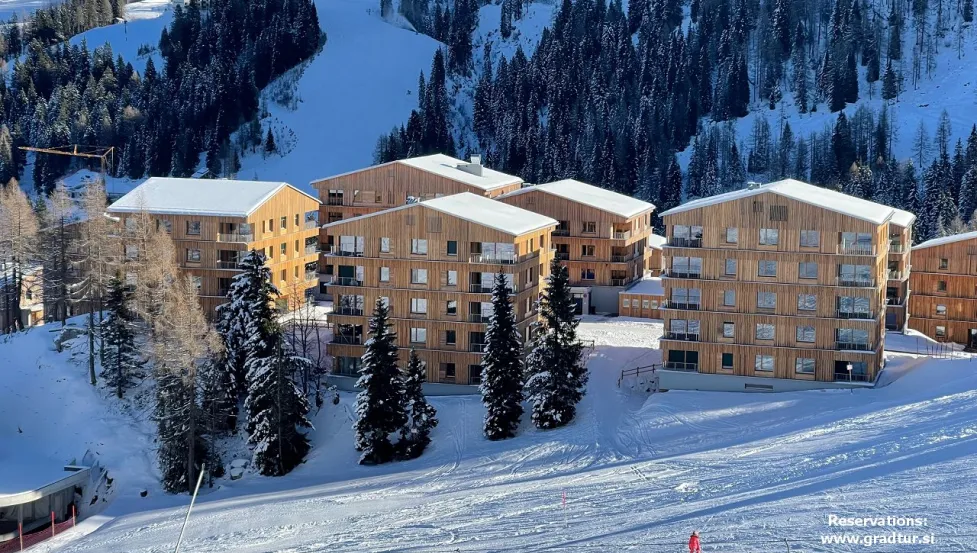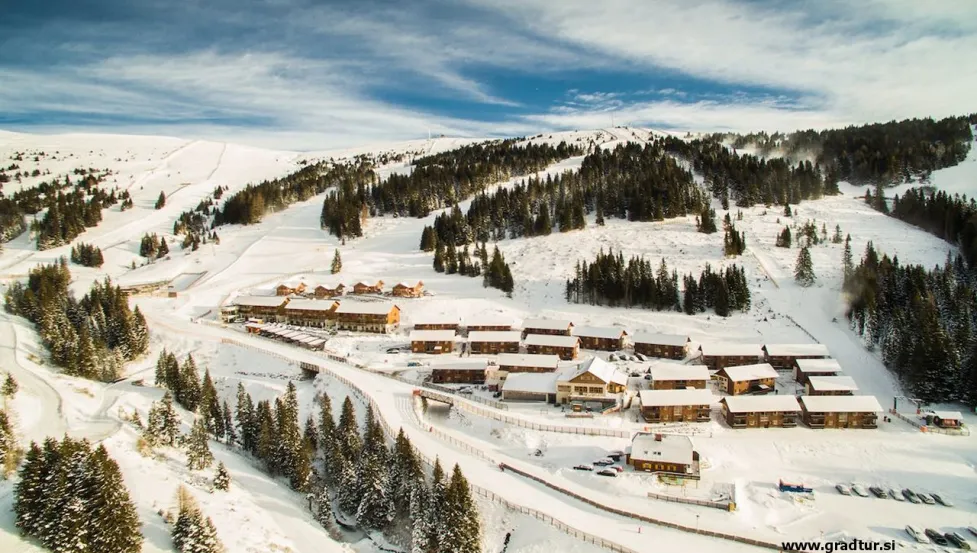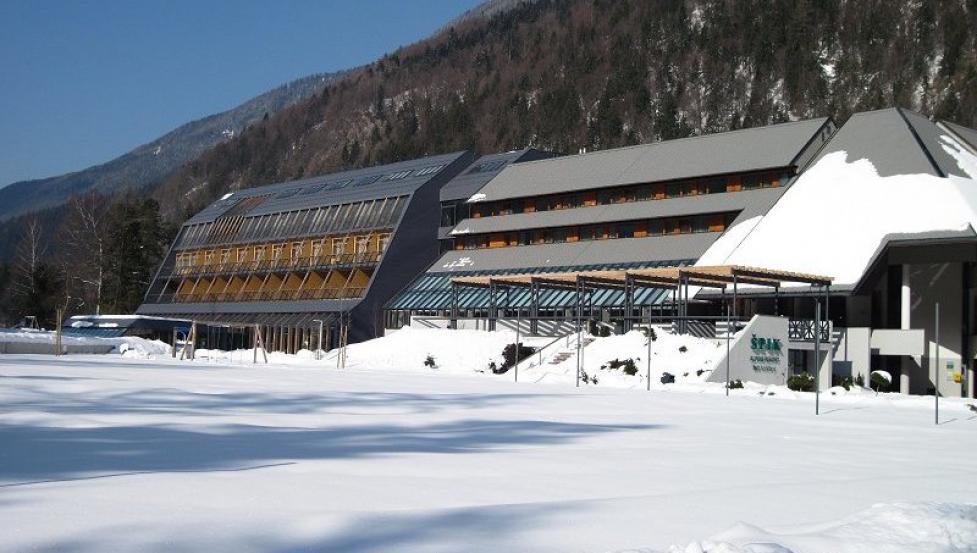Bovec
Bovec is tourist centre of Soča valley, surrounded by tall Alpine mountains. Bovec, Slovenia, Alps
Bovec (Italian: Plezzo, German: Flitsch, Friulian: Plez) is a town in the Littoral region in northwestern Slovenia, close to border with Italy. It is the central settlement of the Municipality of Bovec.
Bovec is a small mountain pearl of Slovenia and of the Triglav National Park. This pleasant little town, surrounded by high peaks of the Julian Alps, is a paradise for all of you who wish to get away from the quick and busy city scene. The picturesque land of the emerald Soča river hides many remote corners where you will find your peace. But Bovec can offer you much more than just relaxation in unspoilt nature and stunning views.
The Soča Valley, with its natural splendours, has long been a favourite among seekers of active experiences in Europe. The valley of staggering waterfalls and playful cascades, pools and ravines offers unforgettable, expert-guided kayaking and rafting tours, canyoning down mysterious tributaries, and other thrilling adventures. The valley’s natural attractions can be seen from the air, paragliding or from an airplane. Caving and hang-gliding enable special interaction with nature. Well-kept hiking, mountain and bicycle trails lead to amazing places and people. In winter, Slovenia’s highest-altitude ski resort at Kanin affords stunning vistas all the way to the sea!
Bovec is a destination of Slovenian superlatives and natural sights
-Boka waterfall, Slovenia's most majestic waterfall,
-Triglav (2864 m), Slovenia's highest mountain,
-Soča river, Europe's most emerald river,
-Krnsko jezero, Slovenia's largest mountain lake,
-Kanin-Sella Nevea (2300 m), Slovenia's highest ski resort (closed until further notice),
-Vršič mountain pass (1611 m), Slovenia's highest mountain pass,
-Mountain road to Mangartsko sedlo, Slovenia's highest mountain road.
Experiences in Bovec
-Kayaking course or rafting trips on the emerald Soča river,
-Walk of Peace from Bovec to the Kluže fort, performance by Društvo 1313,
-Tasting Bovec cheese on the Mangart plain and a visit to Mangartsko sedlo,
-Flying foxes (Zip Line Park),
-Fishing in Lepena,
-Hiking on the Soča Trail from Bovec to Trenta, into the heart of the Triglav National Park. The trail is a part of the popular Alpe Adria Trail,
-Skiing with a view of the sea on the Kanin-Sella Nevea ski slopes (they are being renovated; the cable car and the chair lifts are currently shut down
GEOGRAPHY:
Bovec is located 136 kilometres (85 mi) from the capital Ljubljana, at an elevation of 434 m (1,424 ft). The settlement lies in the Bovec Basin of the upper Soča (Isonzo) River, below the eastern slopes of Mount Kanin in the Julian Alps, forming the border with Italy. The adjacent Trenta Valley in the northwest leads into Triglav National Park.
It has been traditionally part of the historic Gorizia region, but today locals prefer to identify with the wider region of the Slovenian Littoral.
I. AND II. WW AND MASS GRAVES:
During World War I, the area was the theatre of the bloody Battles of the Isonzo, fought between Austro-Hungarian forces and the Italian Army between June 1915 and November 1917, which devastated the region almost completely.
After the war, the military cemetery east of Bovec was expanded and the remains of Austro-Hungarian and Italian soldiers were transferred to the cemetery from surrounding cemeteries. The remains of the Italian soldiers were exhumed and transferred to the Italian military ossuary outside Kobarid in 1938. Over 600 soldiers are buried in the cemetery; the graves cover the entire cemetery area, although only the south quarter has concrete grave markers. There are no names on the grave markers.
Upon the 1918 Battle of Vittorio Veneto, Bovec was occupied by Italian forces and by the 1920 Treaty of Rapallo officially annexed to the Julian March as part of the Kingdom of Italy. Under the Italian Fascist regime between 1922 and 1943, the Slovene-speaking population of Bovec and the neighbouring villages was submitted to a policy of forced Italianization. Numerous locals in turn joined the underground militant anti-fascist TIGR organization, while many others emigrated to the neighbouring Kingdom of Yugoslavia.
Between 1943 and 1945, the area was occupied by Nazi German forces, and units of Slovene partisans were active in the area. After liberation by the Yugoslav People's Army in May 1945, Bovec came under joint British-U.S. occupation. Between June 1945 and September 1947, Bovec and the entire right bank of the Soča River was included in Zone A of the former Julian March, which was under Allied military administration, with the demarcation line with the Yugoslav occupation zone running just a few kilometers east of the town.
Bovec is the site of a mass grave associated with the Second World War. The Cemetery Mass Grave (Slovene: Grobišče na pokopališču) is located next to the entrance to the town cemetery. It contained the remains of 11 German soldiers killed between 1941 and 1945. The names of all of them are known. The grave was exhumed in 2000 and the remains were transferred to Žale Cemetery in Ljubljana. Unlike most mass graves in Slovenia, the grave was well maintained during the communist era with funds provided by the German War Graves Commission. The mass grave is marked by a plaque in Slovene and German.
In September 1947, the Paris Peace Treaties gave the town to Yugoslavia. In 1951, Bovec became a town. With the breakup of Yugoslavia in 1991, Bovec became part of independent Slovenia.
Bovec was heavily damaged by the 1976 Friuli earthquake. Another moderate quake with a magnitude of 5.6 on the Richter scale shook the town in April 1998, and a weaker one occurred in July 2004, with a 4.9 magnitude.
ECONOMY
The citizens of Bovec largely depend on tourism. In recent years, the area has become increasingly popular with advertisers and filmmakers; part of the Disney film The Chronicles of Narnia: Prince Caspian was shot here. The area received the European Destinations of Excellence award in 2008 with the Soča Stories project.
Area destinations include Boka Falls, Mount Triglav (2864 m), the Soča River, Lake Krn, the Kanin (Sella Nevea) ski resort, the Vršič Pass (1611 m), and the mountain road to the Mangart Saddle. Activities around Bovec include kayaking, rafting, hiking (the Peace Trail from Bovec to Fort Kluže, the Soča Trail, and the Alpe-Adria Trail), performances by Društvo 1313, cheese tasting on the Mangart Plain, the Kanin circular cableway, Prestreljenik Window (Slovene: Prestreljeniško okno) and other karst features, a zip line, and fishing.
Bovec (Italian: Plezzo, German: Flitsch, Friulian: Plez) is a town in the Littoral region in northwestern Slovenia, close to border with Italy. It is the central settlement of the Municipality of Bovec.
Bovec is a small mountain pearl of Slovenia and of the Triglav National Park. This pleasant little town, surrounded by high peaks of the Julian Alps, is a paradise for all of you who wish to get away from the quick and busy city scene. The picturesque land of the emerald Soča river hides many remote corners where you will find your peace. But Bovec can offer you much more than just relaxation in unspoilt nature and stunning views.
The Soča Valley, with its natural splendours, has long been a favourite among seekers of active experiences in Europe. The valley of staggering waterfalls and playful cascades, pools and ravines offers unforgettable, expert-guided kayaking and rafting tours, canyoning down mysterious tributaries, and other thrilling adventures. The valley’s natural attractions can be seen from the air, paragliding or from an airplane. Caving and hang-gliding enable special interaction with nature. Well-kept hiking, mountain and bicycle trails lead to amazing places and people. In winter, Slovenia’s highest-altitude ski resort at Kanin affords stunning vistas all the way to the sea!
Bovec is a destination of Slovenian superlatives and natural sights
-Boka waterfall, Slovenia's most majestic waterfall,
-Triglav (2864 m), Slovenia's highest mountain,
-Soča river, Europe's most emerald river,
-Krnsko jezero, Slovenia's largest mountain lake,
-Kanin-Sella Nevea (2300 m), Slovenia's highest ski resort (closed until further notice),
-Vršič mountain pass (1611 m), Slovenia's highest mountain pass,
-Mountain road to Mangartsko sedlo, Slovenia's highest mountain road.
Experiences in Bovec
-Kayaking course or rafting trips on the emerald Soča river,
-Walk of Peace from Bovec to the Kluže fort, performance by Društvo 1313,
-Tasting Bovec cheese on the Mangart plain and a visit to Mangartsko sedlo,
-Flying foxes (Zip Line Park),
-Fishing in Lepena,
-Hiking on the Soča Trail from Bovec to Trenta, into the heart of the Triglav National Park. The trail is a part of the popular Alpe Adria Trail,
-Skiing with a view of the sea on the Kanin-Sella Nevea ski slopes (they are being renovated; the cable car and the chair lifts are currently shut down
GEOGRAPHY:
Bovec is located 136 kilometres (85 mi) from the capital Ljubljana, at an elevation of 434 m (1,424 ft). The settlement lies in the Bovec Basin of the upper Soča (Isonzo) River, below the eastern slopes of Mount Kanin in the Julian Alps, forming the border with Italy. The adjacent Trenta Valley in the northwest leads into Triglav National Park.
It has been traditionally part of the historic Gorizia region, but today locals prefer to identify with the wider region of the Slovenian Littoral.
I. AND II. WW AND MASS GRAVES:
During World War I, the area was the theatre of the bloody Battles of the Isonzo, fought between Austro-Hungarian forces and the Italian Army between June 1915 and November 1917, which devastated the region almost completely.
After the war, the military cemetery east of Bovec was expanded and the remains of Austro-Hungarian and Italian soldiers were transferred to the cemetery from surrounding cemeteries. The remains of the Italian soldiers were exhumed and transferred to the Italian military ossuary outside Kobarid in 1938. Over 600 soldiers are buried in the cemetery; the graves cover the entire cemetery area, although only the south quarter has concrete grave markers. There are no names on the grave markers.
Upon the 1918 Battle of Vittorio Veneto, Bovec was occupied by Italian forces and by the 1920 Treaty of Rapallo officially annexed to the Julian March as part of the Kingdom of Italy. Under the Italian Fascist regime between 1922 and 1943, the Slovene-speaking population of Bovec and the neighbouring villages was submitted to a policy of forced Italianization. Numerous locals in turn joined the underground militant anti-fascist TIGR organization, while many others emigrated to the neighbouring Kingdom of Yugoslavia.
Between 1943 and 1945, the area was occupied by Nazi German forces, and units of Slovene partisans were active in the area. After liberation by the Yugoslav People's Army in May 1945, Bovec came under joint British-U.S. occupation. Between June 1945 and September 1947, Bovec and the entire right bank of the Soča River was included in Zone A of the former Julian March, which was under Allied military administration, with the demarcation line with the Yugoslav occupation zone running just a few kilometers east of the town.
Bovec is the site of a mass grave associated with the Second World War. The Cemetery Mass Grave (Slovene: Grobišče na pokopališču) is located next to the entrance to the town cemetery. It contained the remains of 11 German soldiers killed between 1941 and 1945. The names of all of them are known. The grave was exhumed in 2000 and the remains were transferred to Žale Cemetery in Ljubljana. Unlike most mass graves in Slovenia, the grave was well maintained during the communist era with funds provided by the German War Graves Commission. The mass grave is marked by a plaque in Slovene and German.
In September 1947, the Paris Peace Treaties gave the town to Yugoslavia. In 1951, Bovec became a town. With the breakup of Yugoslavia in 1991, Bovec became part of independent Slovenia.
Bovec was heavily damaged by the 1976 Friuli earthquake. Another moderate quake with a magnitude of 5.6 on the Richter scale shook the town in April 1998, and a weaker one occurred in July 2004, with a 4.9 magnitude.
ECONOMY
The citizens of Bovec largely depend on tourism. In recent years, the area has become increasingly popular with advertisers and filmmakers; part of the Disney film The Chronicles of Narnia: Prince Caspian was shot here. The area received the European Destinations of Excellence award in 2008 with the Soča Stories project.
Area destinations include Boka Falls, Mount Triglav (2864 m), the Soča River, Lake Krn, the Kanin (Sella Nevea) ski resort, the Vršič Pass (1611 m), and the mountain road to the Mangart Saddle. Activities around Bovec include kayaking, rafting, hiking (the Peace Trail from Bovec to Fort Kluže, the Soča Trail, and the Alpe-Adria Trail), performances by Društvo 1313, cheese tasting on the Mangart Plain, the Kanin circular cableway, Prestreljenik Window (Slovene: Prestreljeniško okno) and other karst features, a zip line, and fishing.








 AUSTRIA
AUSTRIA  ITALY
ITALY  SLOVENIA
SLOVENIA 